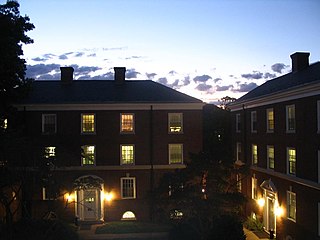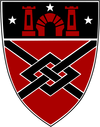Related Research Articles

The University of Virginia (UVA) is a public research university in Charlottesville, Virginia, United States. It was founded in 1819 by Thomas Jefferson and contains his Academical Village, a UNESCO World Heritage Site. The original governing Board of Visitors included three U.S. presidents: Jefferson, James Madison, and James Monroe, the latter as sitting president of the United States at the time of its foundation. As its first two rectors, Presidents Jefferson and Madison played key roles in the university's foundation, with Jefferson designing both the original courses of study and the university's architecture. Located within its historic 1,135 acre central campus, the university is composed of eight undergraduate and three professional schools: the School of Law, the Darden School of Business, and the School of Medicine.

Canonsburg is a borough in Washington County, Pennsylvania, United States, 18 miles (29 km) southwest of Pittsburgh. The population was 9,735 at the 2020 census. Canonsburg was laid out by Colonel John Canon in 1789 and incorporated in 1802. The town lies in a rich coal district, and most of the town's work force once worked in local steel mills or coal mines. Interstate 79 and U.S. Route 19 pass through the town, as does the Pittsburgh and Ohio Central Railroad. A trolley used to operate from Washington, Pennsylvania to Pittsburgh through the borough until 1953.

Morehouse College is a private historically Black men's liberal arts college in Atlanta, Georgia. Anchored by its main campus of 61 acres (25 ha) near Downtown Atlanta, the college has a variety of residential dorms and academic buildings east of Ashview Heights. Along with Spelman College, Clark Atlanta University, and the Morehouse School of Medicine, the college is a member of the Atlanta University Center consortium. Founded by William Jefferson White in 1867 in response to the liberation of enslaved African-Americans following the American Civil War, Morehouse stressed religious instruction in the Baptist tradition. Growth in the mid-20th century led to strengthened finances, increased enrollment, and more academic competitiveness. The college has played a key role in the development of the civil rights movement and racial equality in the United States.

Most United States presidents have kept pets while in office, or pets have been part of their families. Only James K. Polk, Andrew Johnson, and Donald Trump did not have any presidential pets while in office. However, Johnson did take care of some mice he found in his bedroom.

Allegheny College is a private liberal arts college in Meadville, Pennsylvania. Founded in 1815, Allegheny is the oldest college in continuous existence under the same name west of the Allegheny Mountains. It is a member of the Great Lakes Colleges Association and the Presidents' Athletic Conference, and it is accredited by the Middle States Commission on Higher Education.

Washington & Jefferson College is a private liberal arts college in Washington, Pennsylvania. The college traces its origin to three log cabin colleges in Washington County established by three Presbyterian missionaries to the American frontier in the 1780s: John McMillan, Thaddeus Dod, and Joseph Smith. These early schools eventually grew into two competing academies, with Jefferson College located in Canonsburg and Washington College located in Washington. The two colleges merged in 1865 to form Washington & Jefferson College. The 60 acre (0.2 km2) campus has more than 40 buildings, with the oldest dating to 1793.

Westminster College is a private, liberal arts college in New Wilmington, Pennsylvania. Founded in 1852, it is affiliated with the Presbyterian Church (USA). The student population is approximately 1,307 undergraduate and graduate students.

Brown College at Monroe Hill is one of three residential colleges at the University of Virginia. Originally named Monroe Hill College, Brown opened in 1986 as the first modern residential college at the University of Virginia. It was renamed Brown College at Monroe Hill in recognition of the endowment donated by the Brown family in 1994. The college is led by James Coan, Principal, and John T. Casteen IV, Director of Studies. A number faculty fellows from many departments and schools of the university maintain close ties to the college.

Housing at the Massachusetts Institute of Technology (MIT) consists of eleven undergraduate dormitories and nine graduate dorms. All undergraduate students are required to live in an MIT residence during their first year of study. Undergraduate dorms are usually divided into suites or floors, and usually have Graduate Resident Assistants (GRA), graduate students living among the undergraduates who help support student morale and social activities. Many MIT undergraduate dorms are known for their distinctive student cultures and traditions.

Litchfield Towers, commonly referred to on campus as "Towers", is a complex of residence halls at the University of Pittsburgh's main campus in the Oakland neighborhood of Pittsburgh, Pennsylvania. Litchfield Towers is both the largest and tallest residence hall at the University of Pittsburgh, housing approximately 1,850 students.

Forbes Hall is a residence hall of the University of Pittsburgh and is located in Forbes Pavilion on Forbes Avenue approximately four blocks from the Litchfield Towers complex. The name Forbes Hall, which specifically refers to the residence hall component of the building, is sometimes interchangeably used with the name Forbes Pavilion, which refers to the entire six-story structure.

Lothrop Hall is a major student dormitory at the University of Pittsburgh's main campus in the Oakland neighborhood of Pittsburgh, Pennsylvania. Lothrop Hall is located adjacent to the University of Pittsburgh Medical Center (UPMC) on Lothrop Street near Fifth Avenue, this hill is often referred to as "cardiac hill" due to its steep grade and its accessibility to medical care. The Hall is made up of 14 floors, some of which are segregated by sex in each wing. Most rooms in the hall are single occupancy, with some double occupancy as well, and even some tripled on floors 2-10. The dorm houses 723 people, in addition to a resident director and 15 resident assistants.

WNJR is a non-commercial FM radio station broadcasting a freeform radio format. Licensed to Washington, Pennsylvania, it serves Greater Pittsburgh's Southwest suburbs. The station is owned by Washington & Jefferson College.

McMillan Hall is a building on the campus of Washington & Jefferson College in Washington, Pennsylvania, United States. Built in 1793, it is the only surviving building from Washington Academy. It is the eighth-oldest academic building in the United States that is still in use for its original academic purpose and is the oldest surviving college building west of the Allegheny Mountains.

Hays Hall was a residence hall at Washington & Jefferson College. The architectural work was performed by Frederick J. Osterling and it was named after President George P. Hays. Construction was completed in 1903 and the new "fireproof" building was opened to Washington & Jefferson Academy students. Rooms were arranged in a suite style, with communal bathrooms on each floor, and shower baths on the 5th floor. In 1912, the Academy closed and Hays Hall was used by Washington & Jefferson College students. At various times, Hays Hall housed the bookstore and a dining hall. By 1968, Hays Hall had deteriorated to the point where it no longer able to house students, but the bookstore remained. In 1982, the building was declared a fire hazard and closed for all uses. While various efforts sought to renovate or restore Hays Hall, including a push to have it named a historical landmark, Hays Hall was demolished in 1994.
The John A. Swanson Science Center, also known as the Swanson Science Center is an academic building on the campus of Washington & Jefferson College. It was completed in February 2010 and was named after John A. Swanson, an engineer and businessman on the Board of Trustees, who donated $10 million towards its construction. This 47,500 square feet (4,410 m2) facility houses classrooms for Chemistry, Physics, Biophysics and Biochemistry and was designed to match its neighboring historic campus architecture. Its learning facilities include wet and dry teaching laboratories, faculty and student research labs, and a multi-disciplinary lab designed for non-science majors.

Cameron Coca-Cola Bottling Co. was a large Coca-Cola Bottling company in Washington, Pennsylvania.
Pet-friendly residence halls have appeared as a number of colleges and universities in the United States. In 2008, USA Today estimated that at least 12 colleges and universities allows some form of pet-friendly living arrangements. Students at other institutions have advocated for pet-friendly housing policies.

Davison House is a five-story dormitory on the campus of Vassar College in the town of Poughkeepsie, New York. Designed by Boston architecture firm Allen & Vance and built 1902, it was the fourth dorm built on Vassar's residential quadrangle. It houses 191 students of any grade or gender and it became Vassar's first disabled-accessible dorm following a 2008–2009 renovation.
References
- ↑ Wilson, Holly; Amanda J. Gunther (September 9, 2011). "Pets - WJ Student Handbook". Handbook. Washington & Jefferson College. Archived from the original on June 13, 2022. Retrieved February 4, 2012.
- ↑ Miller, Barbara S. (September 4, 2007). "'Pet House' means students don't leave home without 'em". Observer-Reporter . p. B3. Retrieved February 4, 2012.
- ↑ Peters, Sharon (2008-09-23). "Pets take the bite out of dorm life". USA Today . Retrieved 2012-01-21.
- ↑ Steinberg, Jacques (June 5, 2010). "Colleges Extend the Welcome Mat to Students' Pets". The New York Times . Archived from the original on June 19, 2010. Retrieved February 4, 2012.
- ↑ Lytle, Ryan (May 19, 2011). "Bring Your Pet to College". U.S. News & World Report . Archived from the original on 2012-01-27. Retrieved 2012-02-05.
- ↑ "Residential Learning Communities: Theme Communities". Washington & Jefferson College. Archived from the original on August 30, 2012. Retrieved February 4, 2012.
- 1 2 3 4 5 6 Niederberger, Mary (November 11, 2010). "Pet-friendly dorm makes life pleasant at W&J". Pittsburgh Post-Gazette . Retrieved 2012-01-19.
- 1 2 3 Mitchell, Ellen (June 20, 2010). "Washington & Jefferson designates dorm for students with pets". Pittsburgh Tribune Review . Retrieved 2012-01-21.
- 1 2 3 "Washington & Jefferson College Pet House Manual and Pet Registration Form" (PDF). Washington & Jefferson College. Archived from the original (PDF) on June 24, 2013. Retrieved February 4, 2012.
